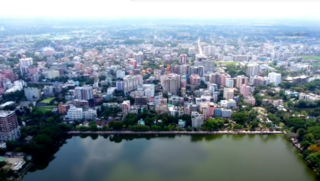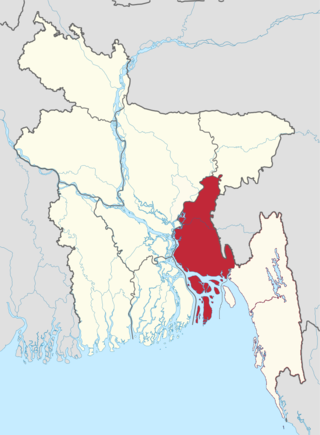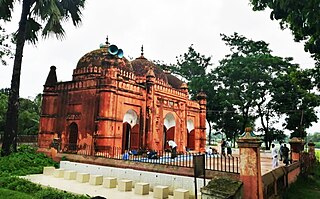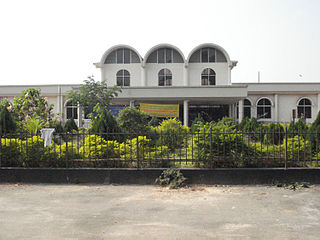
Feni is a coastal district situated in the south-east of Bangladesh, within the Chittagong Division. One of Bangladesh's smallest districts, it is strategically located along the Dhaka–Chittagong transportation corridor. Bordered by India to the north and the Bay of Bengal to the south, it serves as the sole entry point linking Chittagong, the country's primary port city, to the northern districts.

Chittagong Division, officially known as Chattogram Division, is geographically the largest of the eight administrative divisions of Bangladesh. It covers the south-easternmost areas of the country, with a total area of 34,529.97 km2 (13,332.10 sq mi) and a population at the 2022 census of 33,202,326. The administrative division includes mainland Chittagong District, neighbouring districts and the Chittagong Hill Tracts.

Chandpur District (চাঁদপুর) is a district located in Chattogram Division of Bangladesh. It was part of the Comilla District until 15 February 1984.

Brahmanbaria is a district in eastern Bangladesh located in the Chittagong Division. Geographically, it is mostly farmland and is topographically part of the Gangetic Plain. It is bounded by the districts of Kishoreganj and Habiganj to the north, Narsingdi District and Narayanganj to the west, Comilla to the south, and the Indian state of Tripura to the east. It was a part of Comilla District until 15 February 1984.

Lakshmipur is a district in Bangladesh with an area of 1,440 km2. It is bordered by Chandpur to the north, Bhola and Noakhali districts to the south, Noakhali to the east, and Barisal and Bhola districts to the west. Lakshmipur was part of Noakhali until 15 February 1984, when the western part of Noakhali was reorganised from Lakshmipur subdivision into Lakshmipur district to improve administrative efficiency.

Burichang, also known as Burichong, is an upazila of Comilla District in the Division of Chittagong, Bangladesh.

Chauddagram is an upazila of Cumilla District in the Division of Chittagong, Bangladesh. It also a Municipality under Cumilla District.Chauddagram Municipality is a part of Chauddagram Upazila. A municipality in Comilla district of Bangladesh.

Laksam is an upazila of Comilla District in the Division of Chittagong, Bangladesh. Laksam is widely known as the birthplace of Nawab Faizunnesa Chowdhurani.

Muradnagar is an upazila of the Comilla District in Chittagong Division, Bangladesh.

Boalmari is an upazila (sub-district) of Faridpur District in central Bangladesh, located in the Dhaka Division. It is named after its headquarters, the town of Boalmari.

Comilla, officially spelled Cumilla, is a metropolis on the banks of the Gomti River in eastern Bangladesh. Comilla was one of the cities of ancient Bengal. It was once the capital of Tripura kingdom. Comilla Airport is located in the Dulipara area of Comilla city Although it is currently replaced with Comilla Export Processing Zone (EPZ). Comilla City is a division centered city district with surrounding districts coming to Comilla in more diverse areas of work. Bibir Bazar land port is located 5 km away from Comilla city. The area of Comilla City Corporation is 53.04 square kilometers, so the surrounding areas of the main city fall under the jurisdiction of the City Corporation. The urban areas falling outside the city corporation are considered as suburbs with a population of 600,000.

The Comilla University is a public university located at Kotbari, Comilla, Bangladesh. The university was constructed on 244.19 acres of land at Shalban Vihara, Moynamoti, Kotbari. Comilla University is affiliated by University Grants Commission, Bangladesh.

Comilla Victoria Government College, mostly known as Comilla Victoria College, is a government college in Comilla, Bangladesh. It is one of the oldest and most renowned colleges in Comilla as well as in the Chittagong division. The degree and honours branch of the college is located in Dharmapur area of Cumilla district. The college was named after Queen Victoria, once the Queen of British Raj.

The divisions of Bangladesh are further divided into districts or zilas. The headquarters of a district is called the district seat. There are 64 districts in Bangladesh. The districts are further subdivided into 495 subdistricts or upazilas.

Meghna Division, also known as Comilla Division, is a proposed administrative division within Bangladesh for the north-western parts of the existing Chittagong Division, comprising Brahmanbaria, Comilla, Chandpur, Noakhali, Feni, and Laxmipur Districts of Chittagong Division. The headquarter of the division would be in Comilla. It covers the south-easternmost areas of the country, with a total area of 12,848.53 km2 (4,960.85 sq mi) and a population at the 2011 census of 16,708,000.
Comilla is a most popular city in Bangladesh. There are many schools in the city. As of 2018 the number of the primary schools in the city was 2,102.

Monohorgonj is an upazila of Comilla District in the Division of Chittagong, Bangladesh.

The Board of Intermediate and Secondary Education, Cumilla is an autonomous organization that is responsible for holding public examinations Junior School Certificate (J.S.C.), Secondary School Certificate (S.S.C.), and Higher Secondary (School) Certificate (H.S.C) in the Cumilla District and five nearby districts of Meghna Division. The board was established in 1962 under The Intermediate and Secondary Education Ordinance, 1961 which was amended on 1977 as Intermediate and Secondary Education (Amendment) Ordinance, 1977.

Nawab Faizunnesa Government College (NFGC) is a government college at Laksam, Cumilla, Bangladesh. This college is also known as "Faizunnesa College." As a result of freeing the college from political instability, the college has been recognized as one of the best academic institutions of the upazila.

Akhaura Junction railway station is a railway junction located in Akhaura Upazila, Brahmanbaria District, Chittagong division, Bangladesh.




























